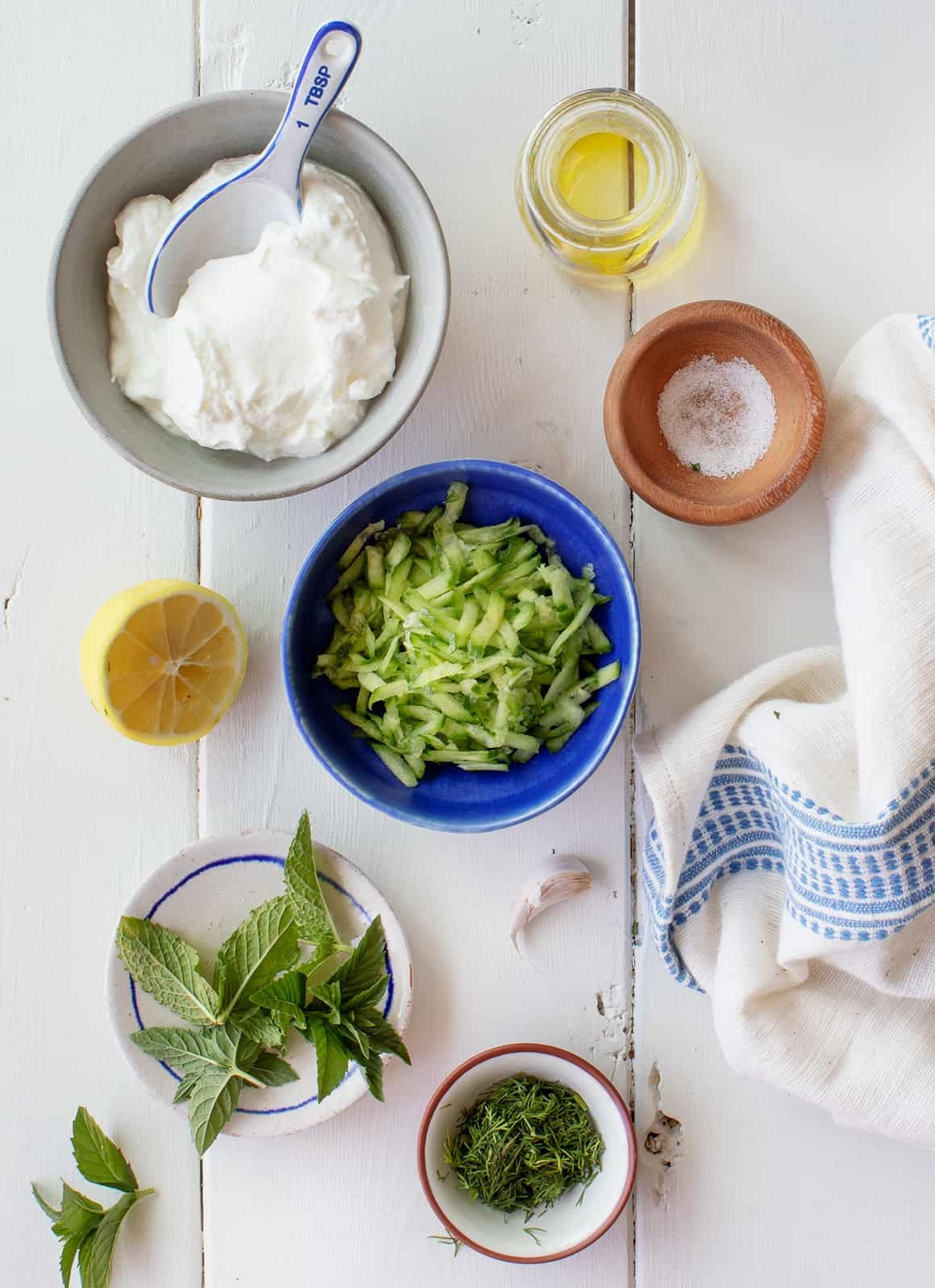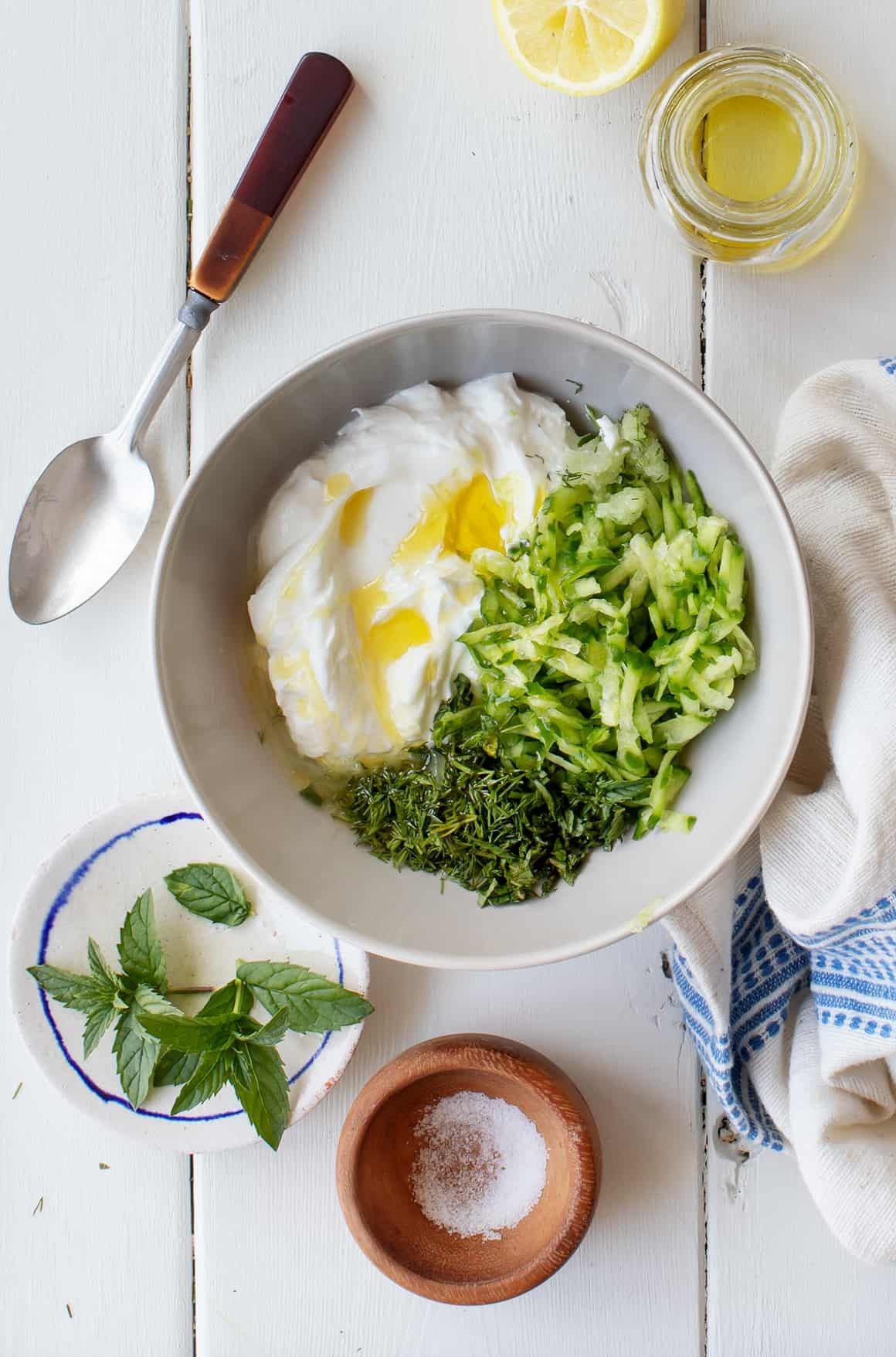What Is Tzatziki Sauce? This creamy, refreshing condiment is a staple in Greek cuisine and beyond. Discover its origins, ingredients, variations, and countless ways to enjoy this versatile sauce, plus, uncover the secrets to making the perfect tzatziki right at home. Seeking answers to culinary questions? WHAT.EDU.VN offers a wealth of knowledge and a platform to ask anything. Explore delightful tastes, creamy textures, and Greek flavors with this classic dip.
Table of Contents
- What is Tzatziki Sauce? The Basics
- Tzatziki Sauce Ingredients: What You’ll Need
- A Step-by-Step Guide: How to Make Tzatziki Sauce
- Tzatziki Sauce Variations: Exploring Different Flavors
- Serving Suggestions: What to Eat with Tzatziki Sauce
- Health Benefits of Tzatziki Sauce
- Storing Tzatziki Sauce: Tips and Tricks
- Tzatziki vs. Other Dips: A Comparison
- Tzatziki Sauce Around the World: Regional Twists
- Frequently Asked Questions (FAQs) About Tzatziki Sauce
1. What is Tzatziki Sauce? The Basics
Tzatziki is a traditional Greek sauce or dip made primarily from strained yogurt, grated cucumber, garlic, olive oil, and fresh herbs like dill and mint. A touch of lemon juice or vinegar adds a tangy zest. It’s a cool, refreshing sauce that perfectly complements various dishes, especially during warmer months. Tzatziki is known for its creamy texture and vibrant flavor, making it a popular condiment worldwide. It offers a delightful burst of flavor and a cooling sensation that enhances any meal. You can learn more about global flavors and recipes at WHAT.EDU.VN, where you can also ask any culinary question that comes to mind.
2. Tzatziki Sauce Ingredients: What You’ll Need
To make authentic tzatziki sauce, you’ll need the following essential ingredients:
- Strained Yogurt: Use thick, full-fat Greek yogurt. Straining the yogurt beforehand removes excess whey, resulting in a creamier texture.
- Cucumber: English cucumbers or Persian cucumbers work well. Remove the seeds and grate the cucumber. Be sure to squeeze out the excess water to prevent a watery sauce.
- Garlic: Fresh garlic cloves add a pungent, aromatic flavor. Grate or mince the garlic finely.
- Olive Oil: Extra virgin olive oil lends a rich, fruity flavor and smooth texture.
- Fresh Herbs: Dill and mint are the most common herbs used in tzatziki. Chop them finely for the best flavor.
- Lemon Juice or Vinegar: A squeeze of fresh lemon juice or a splash of white wine vinegar adds a bright, tangy element.
- Salt: Season the sauce with salt to enhance the other flavors.
Here’s a simple table summarizing the ingredients:
| Ingredient | Quantity | Notes |
|---|---|---|
| Strained Yogurt | 1 cup | Full-fat Greek yogurt is ideal |
| Cucumber | 1/2 cup grated | Remove seeds and squeeze out excess water |
| Garlic | 1-2 cloves | Minced or grated finely |
| Olive Oil | 1 tbsp | Extra virgin olive oil |
| Fresh Dill | 1 tbsp chopped | Adds a classic tzatziki flavor |
| Fresh Mint | 1 tbsp chopped | Optional, but enhances the freshness |
| Lemon Juice/Vinegar | 1 tsp | Adjust to taste |
| Salt | 1/4 tsp | To taste |



These ingredients combine to create the traditional tzatziki flavor profile. For any questions about ingredient substitutions or variations, visit WHAT.EDU.VN to connect with culinary experts.
3. A Step-by-Step Guide: How to Make Tzatziki Sauce
Making tzatziki sauce at home is quick and easy. Follow these simple steps:
- Prepare the Cucumber: Grate the cucumber using a box grater. Place the grated cucumber in a clean kitchen towel or cheesecloth and squeeze out as much liquid as possible. This step is essential to prevent the sauce from becoming watery.
- Combine Ingredients: In a medium-sized bowl, combine the strained yogurt, squeezed cucumber, minced garlic, olive oil, lemon juice (or vinegar), chopped dill, and chopped mint (if using).
- Season: Add salt to taste and mix well until all ingredients are thoroughly combined.
- Chill: Cover the bowl and refrigerate the tzatziki sauce for at least 30 minutes to allow the flavors to meld. Chilling also enhances the texture and consistency.
- Serve: After chilling, stir the sauce again and serve as a dip, spread, or condiment.
Here’s a visual guide to the process:
This straightforward process ensures a delicious, homemade tzatziki sauce every time. If you encounter any issues or have further questions, the community at WHAT.EDU.VN is ready to help.
4. Tzatziki Sauce Variations: Exploring Different Flavors
While the classic tzatziki recipe is delicious, you can explore various flavor variations to suit your taste:
- Spicy Tzatziki: Add a pinch of red pepper flakes or a dash of hot sauce to the mixture for a spicy kick.
- Lemon-Herb Tzatziki: Increase the amount of lemon juice and add other fresh herbs like parsley or oregano for a more herbaceous flavor.
- Vegan Tzatziki: Substitute the Greek yogurt with a plant-based yogurt alternative like coconut yogurt or soy yogurt. Ensure the yogurt is thick and creamy for the best results.
- Roasted Garlic Tzatziki: Roast the garlic cloves before adding them to the sauce for a milder, sweeter garlic flavor.
- Avocado Tzatziki: Blend a ripe avocado into the mixture for added creaminess and a healthy twist.
Here’s a table summarizing the variations:
| Variation | Key Ingredient/Change | Flavor Profile |
|---|---|---|
| Spicy Tzatziki | Red pepper flakes or hot sauce | Spicy, tangy, refreshing |
| Lemon-Herb Tzatziki | Increased lemon juice, parsley, oregano | Herbaceous, tangy, bright |
| Vegan Tzatziki | Plant-based yogurt alternative (coconut, soy) | Creamy, tangy, plant-based |
| Roasted Garlic | Roasted garlic cloves | Mild, sweet, aromatic |
| Avocado Tzatziki | Ripe avocado | Creamy, rich, healthy |
Experimenting with these variations can help you discover your perfect tzatziki recipe. If you’re looking for more unique flavor combinations, ask our community at WHAT.EDU.VN for inspiration.
5. Serving Suggestions: What to Eat with Tzatziki Sauce
Tzatziki sauce is incredibly versatile and pairs well with various dishes. Here are some popular serving suggestions:
- As a Dip: Serve with pita bread, crackers, or fresh vegetables like carrots, celery, and bell peppers.
- With Grilled Meats: Drizzle over grilled chicken, lamb, or beef for added flavor and moisture.
- In Sandwiches and Wraps: Spread on sandwiches, gyros, or wraps for a creamy, refreshing element.
- With Seafood: Serve alongside grilled or baked fish, shrimp, or calamari.
- With Falafel: Top falafel sandwiches or platters with tzatziki for a classic Mediterranean combination.
- With Salads: Use as a dressing for salads, especially those with Mediterranean-inspired ingredients.
- With Roasted Vegetables: Drizzle over roasted vegetables like eggplant, zucchini, and tomatoes.
Here’s a list of pairings:
- Pita bread and vegetables
- Grilled chicken or lamb
- Falafel wraps
- Greek salad
- Roasted vegetables
These serving suggestions highlight the versatility of tzatziki sauce. For more creative ideas and pairings, seek guidance from the culinary experts at WHAT.EDU.VN.
6. Health Benefits of Tzatziki Sauce
Tzatziki sauce offers several health benefits, thanks to its nutritious ingredients:
- Probiotics: Greek yogurt contains probiotics, which promote gut health and support the immune system.
- Low in Calories: Tzatziki is relatively low in calories compared to other creamy sauces and dressings.
- Hydrating: Cucumber has a high water content, contributing to hydration.
- Rich in Nutrients: Garlic, dill, and mint provide essential vitamins and minerals.
- Good Source of Protein: Greek yogurt is a good source of protein, which helps with satiety and muscle building.
However, it’s essential to consider the following:
- Sodium Content: Be mindful of the salt content, especially if you’re watching your sodium intake.
- Fat Content: While Greek yogurt is a healthier option, it still contains fat. Choose low-fat or non-fat versions if you prefer.
Here’s a breakdown of the benefits:
- Gut Health: Probiotics from Greek yogurt aid digestion.
- Hydration: Cucumber keeps you hydrated.
- Nutrient-Rich: Garlic, dill, and mint provide vitamins and minerals.
Consult a nutritionist or healthcare professional for personalized dietary advice. If you have specific health-related questions about tzatziki or other foods, ask our experts at WHAT.EDU.VN for reliable information.
7. Storing Tzatziki Sauce: Tips and Tricks
To properly store tzatziki sauce and maintain its freshness, follow these tips:
- Refrigerate Promptly: Store tzatziki sauce in an airtight container in the refrigerator as soon as possible after making it.
- Use an Airtight Container: An airtight container prevents the sauce from absorbing odors from other foods in the fridge.
- Consume Within a Week: Tzatziki sauce is best consumed within 3-5 days of making it. After this time, the texture and flavor may start to deteriorate.
- Avoid Freezing: Freezing tzatziki sauce is not recommended as it can alter the texture and cause it to separate.
- Stir Before Serving: Before serving, stir the sauce well to redistribute any accumulated liquid.
Here’s a quick guide:
- Refrigerate: Store in an airtight container immediately.
- Consume Within: 3-5 days for best quality.
- Avoid: Freezing, as it affects texture.
Proper storage ensures your tzatziki sauce remains delicious and safe to eat. If you have questions about food storage or safety, WHAT.EDU.VN offers expert advice.
8. Tzatziki vs. Other Dips: A Comparison
Tzatziki is often compared to other creamy dips and sauces. Here’s a comparison to help you understand its unique qualities:
- Tzatziki vs. Hummus: While both are popular Mediterranean dips, hummus is made from chickpeas, tahini, lemon juice, and garlic. Tzatziki is lighter and tangier due to the yogurt and cucumber.
- Tzatziki vs. Ranch: Ranch dressing is typically made from buttermilk, mayonnaise, herbs, and spices. Tzatziki is healthier, with probiotics from yogurt and fresh ingredients.
- Tzatziki vs. Sour Cream Dip: Sour cream dips often use a sour cream base with various seasonings. Tzatziki has a distinct Mediterranean flavor profile with cucumber, garlic, and dill.
Here’s a summary table:
| Dip | Base Ingredient | Key Flavors | Origin |
|---|---|---|---|
| Tzatziki | Greek Yogurt | Cucumber, garlic, dill, lemon | Greece |
| Hummus | Chickpeas | Tahini, lemon, garlic | Middle East |
| Ranch | Buttermilk | Herbs, spices, garlic, onion | USA |
| Sour Cream | Sour Cream | Varies depending on seasonings (onion, herbs) | Varies |
Each dip offers a unique flavor and texture. For more comparisons and culinary insights, visit WHAT.EDU.VN and ask our knowledgeable community.
9. Tzatziki Sauce Around the World: Regional Twists
While tzatziki is traditionally Greek, it has variations in different regions:
- Greece: Authentic Greek tzatziki often uses sheep or goat yogurt for a richer flavor.
- Turkey: Known as “cacık,” Turkish tzatziki is often thinner and used as a soup or beverage, especially during the summer.
- Cyprus: Cypriot tzatziki may include local herbs and spices, reflecting the island’s unique culinary influences.
- Middle East: Variations exist with regional herbs and spices, often served as part of a mezze platter.
These regional twists showcase the adaptability of tzatziki.
Here are a few examples:
- Turkish cacık: Thinner, soup-like consistency.
- Cypriot tzatziki: Local herbs and spices.
- Middle Eastern versions: Regional herbs and spices.
To explore more global culinary traditions and regional variations, WHAT.EDU.VN is your go-to resource. Ask questions and share your own culinary experiences.
10. Frequently Asked Questions (FAQs) About Tzatziki Sauce
Here are some frequently asked questions about tzatziki sauce:
Q1: Can I use regular yogurt instead of Greek yogurt?
A: While you can use regular yogurt, Greek yogurt is preferred because it’s thicker and creamier. If using regular yogurt, strain it first to remove excess whey.
Q2: How do I prevent my tzatziki sauce from becoming watery?
A: The key is to squeeze as much liquid as possible from the grated cucumber before adding it to the yogurt.
Q3: Can I make tzatziki sauce ahead of time?
A: Yes, tzatziki sauce can be made a day or two in advance. The flavors will meld together, enhancing the taste.
Q4: Is tzatziki sauce gluten-free?
A: Yes, tzatziki sauce is naturally gluten-free as it doesn’t contain any wheat, barley, or rye.
Q5: Can I use dried herbs instead of fresh herbs?
A: Fresh herbs are recommended for the best flavor, but you can use dried herbs in a pinch. Use about 1 teaspoon of dried herbs for every tablespoon of fresh herbs.
Q6: What can I substitute for garlic in tzatziki sauce?
A: If you’re sensitive to garlic, you can use a small amount of garlic powder or omit it altogether. Roasted garlic is a milder option.
Q7: How long does tzatziki sauce last in the refrigerator?
A: Tzatziki sauce typically lasts for 3-5 days in the refrigerator when stored in an airtight container.
Q8: Can I freeze tzatziki sauce?
A: Freezing tzatziki sauce is not recommended as it can alter the texture and cause it to separate upon thawing.
Q9: What are some good vegan alternatives for Greek yogurt in tzatziki?
A: Coconut yogurt, soy yogurt, and cashew yogurt are excellent vegan alternatives. Ensure they are thick and creamy for the best results.
Q10: Can I add other vegetables to tzatziki sauce?
A: Yes, you can add other finely grated vegetables like carrots or zucchini for added flavor and texture.
This FAQ section addresses common questions about tzatziki sauce. For more detailed answers or to ask your own questions, visit WHAT.EDU.VN.
Have more questions or need further clarification? Don’t hesitate to visit WHAT.EDU.VN, where you can ask any question and receive free, reliable answers from our community of experts. We are located at 888 Question City Plaza, Seattle, WA 98101, United States. You can also reach us via WhatsApp at +1 (206) 555-7890. what.edu.vn is here to provide you with the knowledge you seek, making learning and discovery accessible to everyone.
